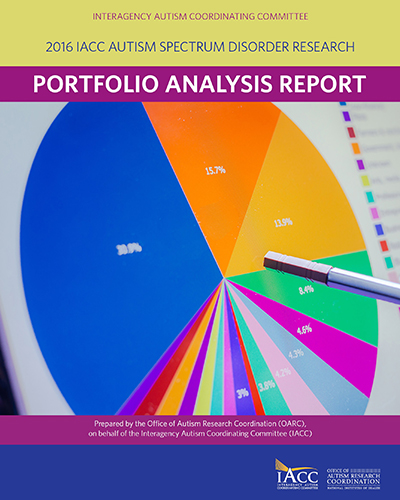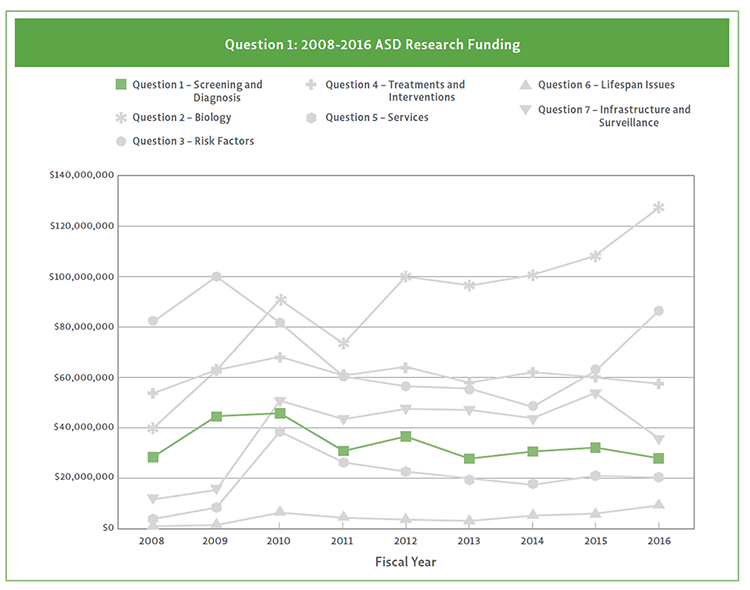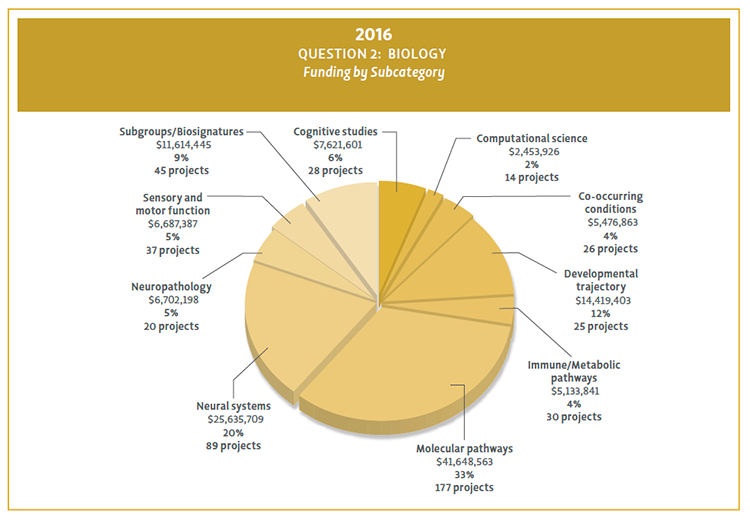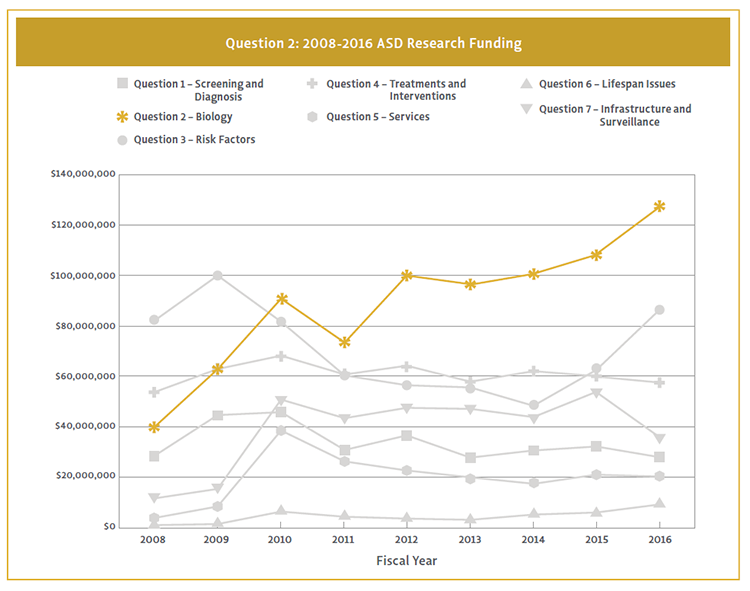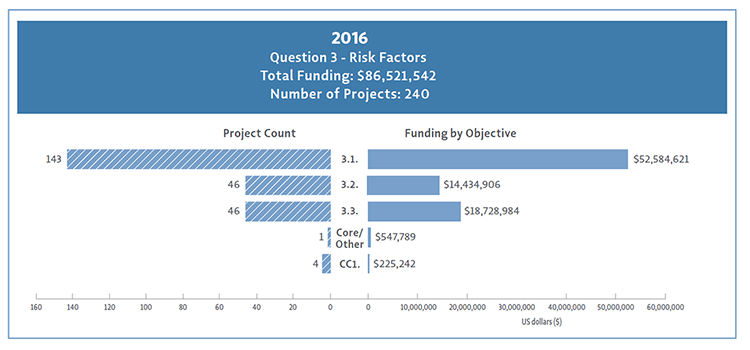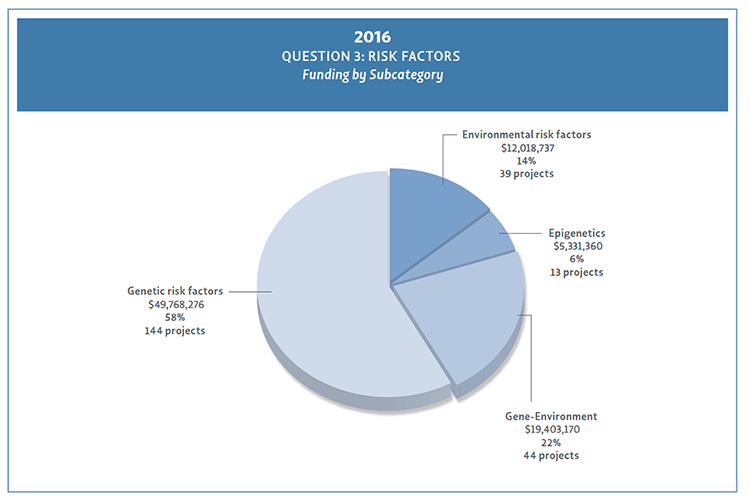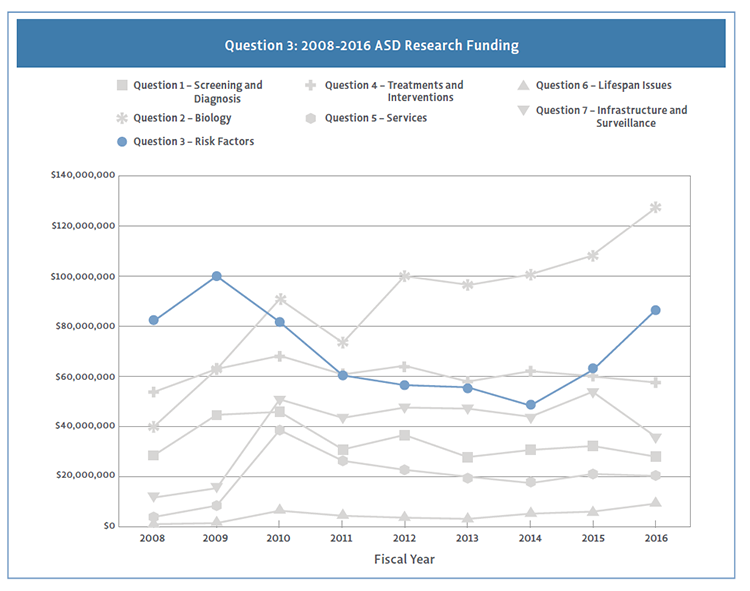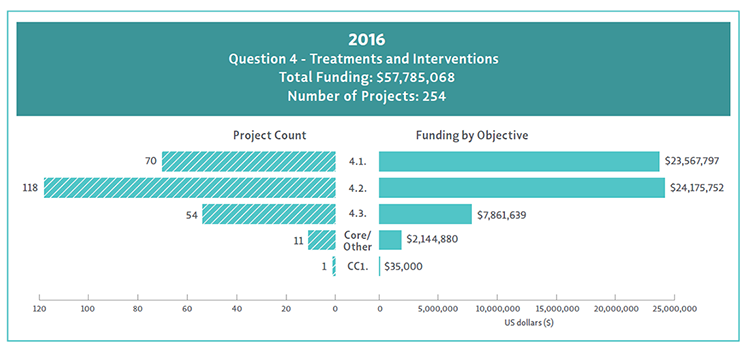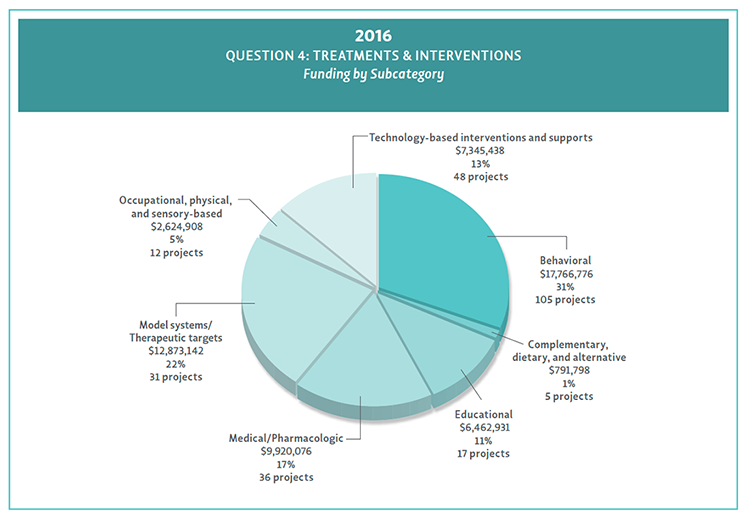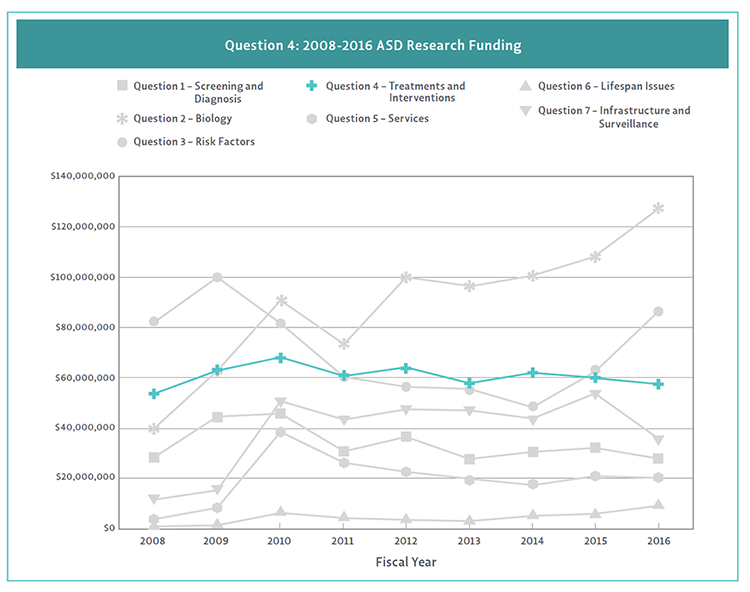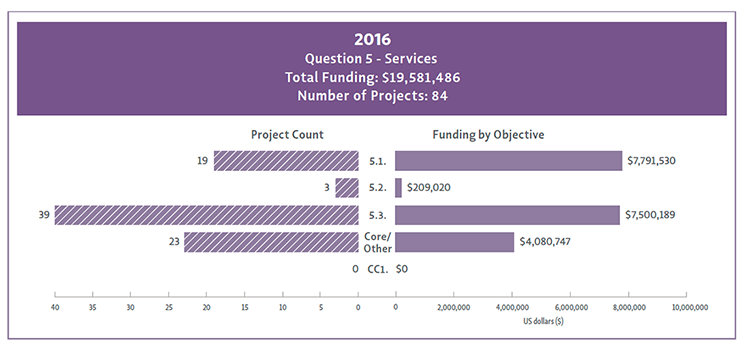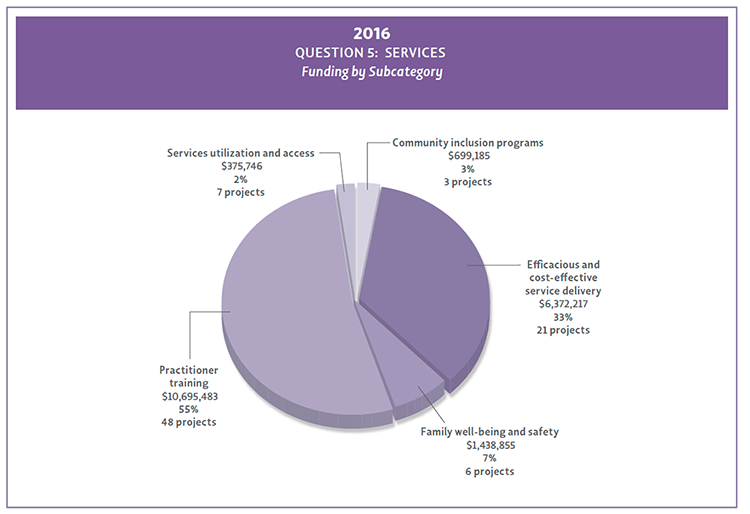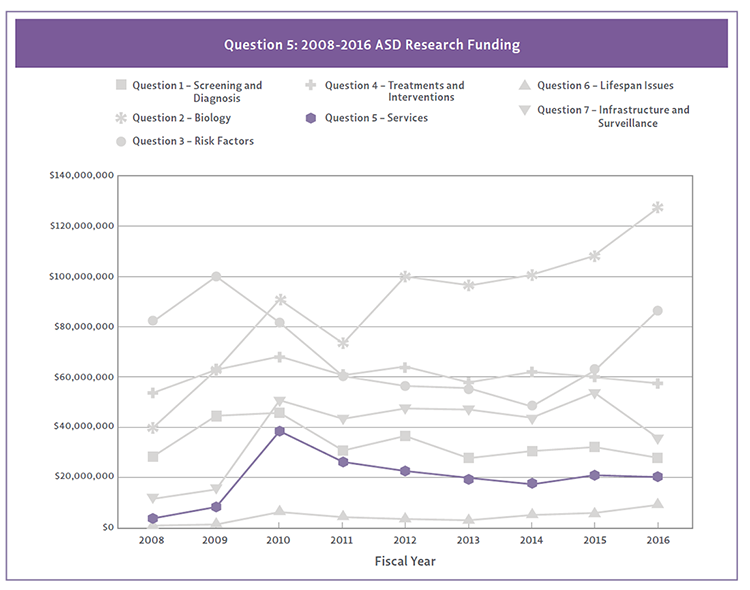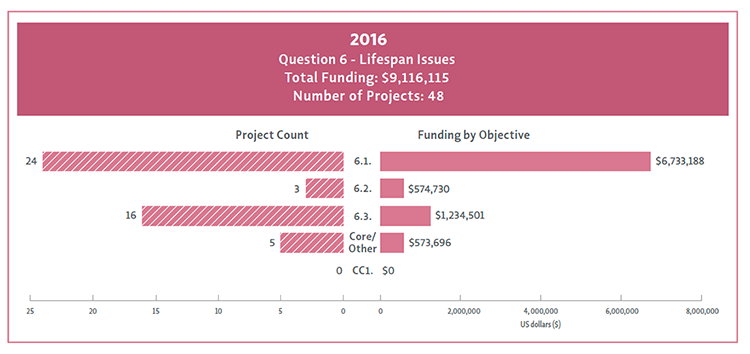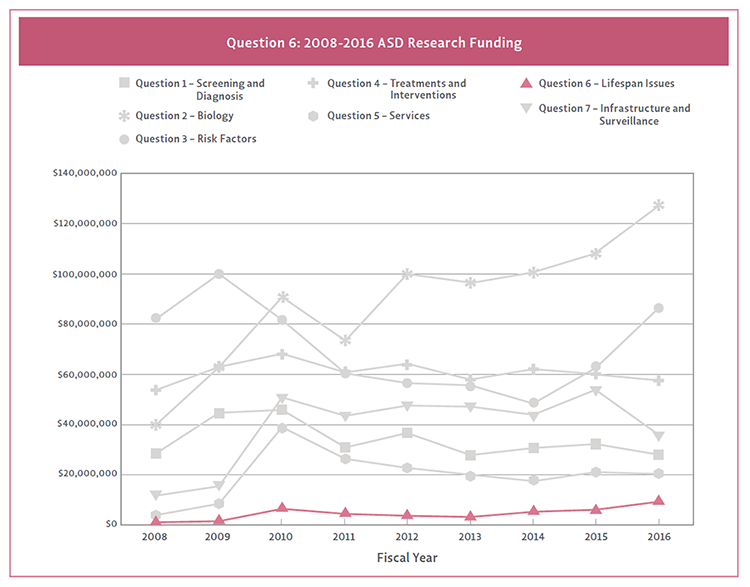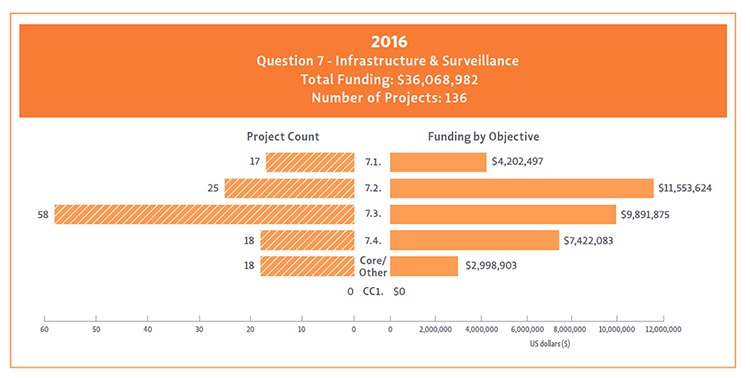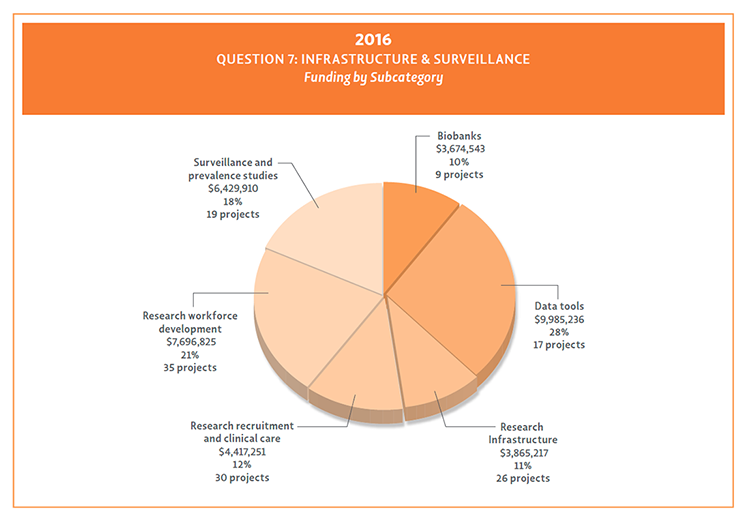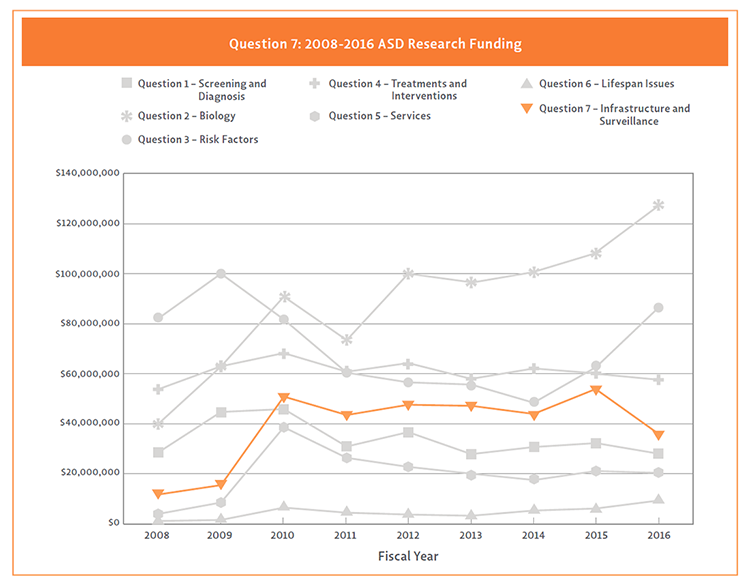Portfolio Analysis Report
IACC Autism Spectrum Disorder Research
2016


Aspirational goal: Provide the earliest possible diagnosis for people on the autism spectrum, so they can be linked to appropriate interventions, services, and supports in as timely a manner as possible to maximize positive outcomes.
Research Focus of Question 1
Question 1 of the IACC Strategic Plan (“How can I recognize the signs of ASD, and why is early detection so important?”) pertains to the issues surrounding screening for and diagnosis of ASD, with a focus on early identification so that children will have the opportunity to receive interventions and supports that will lead to improved outcomes. The objectives within this section of the Strategic Plan include research to develop and improve biomarkers, screening tools, and diagnostic instruments to aid in early identification. Question 1 topics also include research to reduce disparities in early detection, including efforts to increase access to health services, and to strengthen the evidence base for the benefits of early detection of ASD. In addition, the Committee prioritized the need for screening and diagnostic tools for use in adolescents and adults; projects addressing issues related to adult screening and diagnosis are captured within Question 6 of the Strategic Plan (focused on issues relevant to transitioning youth and adults on the autism spectrum).
In an effort to describe the research funded in 2016 related to Question 1, a word cloud was generated using the project titles listed under this question (depicted above). The size of each word within the word cloud indicates the frequency of its use in project titles. The word cloud visually portrays the main research themes and topics that were associated with projects categorized under Question 1.
Analysis Of 2016 Question 1 Portfolio
When analyzing the distribution of research dollars across the seven question areas described in the IACC Strategic Plan, projects assigned to Question 1 comprised 8% ($28 million) of the total ASD research in 2016. A total of 107 projects were assigned to Question 1, which was 8% of all projects. The largest funders of research pertaining to Question 1 in 2016 were the NIH, SF and HRSA. With the new Strategic Plan, progress made on Question 1 is measured through three primary objectives and one cross-cutting objective. Figure 17 provides a detailed overview of each objective’s total funding in 2016 as well as the number of projects assigned to each objective.
In 2016, all three Question 1 primary objectives received funding. The Question 1 objective receiving the most funding was 1.3, which aims to improve and develop new tools and service models for detecting ASD; it received 71% ($19.9 million) of the Question 1 funding and consisted of majority of the Question 1 projects (82 projects). This was followed by objective 1.2, which focuses on reducing disparities in early detection and access to services. Objective 1.2 accounted for 24% ($6.7 million) of Question 1 funding and included 16 projects. Objective 1.1 received 4% ($1.1 million) of Question 1 funding and had 5 projects; the goal of this objective is to strengthen the evidence base for the benefits of early detection of ASD. Only 1% of Question 1 funding went to projects categorized as Core/Other, these are projects not specific to Question 1 objectives. Projects assigned to Core/Other included research on new technologies assessing early signs in visual and motor functioning and research on the development of symptoms associated with social and vocal engagement. The cross-cutting objective (CC1), which focuses on understanding the sex differences in screening and diagnosing ASD under Question 1, did not have any projects in 2016.
Figure 17. 2016 funding and project count by Question 1 objectives.
Question 1 Subcategory Analysis
With the development of the subcategory categorization scheme for the IACC ASD Research Portfolio Analysis, all projects can be categorized into broad research-related topic areas or themes, including projects that did not fit within the specific research objectives laid out in the Strategic Plan. This enables a more comprehensive understanding of the distribution of all projects across the general research areas aligning with Question 1. Overall, projects in Question 1 were divided into four subcategories: Diagnostic and screening tools; Early signs and biomarkers; Intermediate phenotypes/Subgroups; and Symptomology (Figure 18).
Of these four subcategories, the largest proportion of 2016 funding was devoted to the development of Diagnostic and screening tools for ASD (49%). Identifying Early signs and biomarkers was the second largest research investment in Question 1 (28%). Included in this subcategory were biological indicators (including genetic, metabolic, and brain structure/ connectivity) and behavioral biomarkers that can be used for screening/diagnosis or to measure progress or treatment response. This was followed by research on identifying/characterizing Intermediate phenotypes/ Subgroups of people with ASD (15%). The subcategory receiving the lowest proportion of funding included research characterizing Symptomology (8%).
Figure 18. Question 1 funding by subcategory in 2016.
Progress Made On Question 1 From 2008-2016
Figure 19 shows the trend in Question 1 funding over time. When considering annual funding for Question 1 from 2008-2016, portfolio analysis data showed that funding levels stayed relatively flat since 2008, with the exception of 2009 and 2010, during which federal funding for autism research was increased due to the American Recovery and Reinvestment Act.
Figure 19. Question 1 ASD research funding from 2008-2016. Funding for Question 1 was moderate and stayed relatively flat over the nineyear span.


Aspirational goal: Discover how alterations in brain development and the function of physiological systems lead to ASD in order to enable the development of effective, targeted interventions and societal accommodations that improve quality of life for people on the autism spectrum.
Research Focus of Question 2
Question 2 (“What is the biology underlying ASD?”) seeks to understand the biological differences and mechanisms in early development and throughout life that contribute to ASD symptoms, as well as the characterization of the behavioral and cognitive aspects of ASD. The aim of the research represented by Question 2 is to understand the biological processes underlying ASD from the molecular level to sensory, motor, behavioral, and cognitive development and functioning. Projects range from basic neuroscience using cellular and animal models to clinical studies.
A word cloud was created using the project titles listed under Question 2 to provide a visual representation of the research funded in 2016 (depicted above). The size of each word within the word cloud indicates the frequency of its use in project titles. The word cloud visually depicts the main research themes and topics that were associated with projects categorized under Question 2.
Analysis of 2016 Question 2 Portfolio
Among the seven question areas described in the IACC Strategic Plan, Question 2 accounted for the largest portion of the ASD research portfolio in 2016. Following similar trends as previous years, research on the biology of ASD (Question 2) comprised 35% of total funding ($127.4 million). Question 2 also had the largest portion of overall projects in 2016 (36%, 491 projects). Among federal agencies and private organizations, the National Institutes of Health provided the largest investment, contributing 89% of total Question 2 research funding. The Simons Foundation was the next largest funder for Question 2. Research funding under Question 2 is categorized under three primary objectives and one cross-cutting objective. Figure 20 provides a detailed overview of each objective’s total funding in 2016 as well as the number of projects assigned to each objective.
All three primary objectives in Question 2 and the cross-cutting objective received funding in 2016. The majority of projects were categorized under objective 2.1, with 75% of Question 2 funding ($96 million). The aim of this objective is to better understand the biological, molecular, and brain processes that contribute to ASD. The next largest portion of funding went to objective 2.3 (10% of funding; $12.9 million), which focuses on supporting large-scale longitudinal studies that assess the natural lifespan of ASD. Objective 2.2, which emphasizes research in understanding co-occurring conditions, received $8.4 million and accounted for 7% of Question 2 funding. The cross-cutting objective (CC1) received 4% of funding ($4.9 million) in 2016 under Question 2. The goal for the cross-cutting objective within Question 2 is to understand the biological basis of sex differences in ASD, such as differences in brain structure and functioning among girls and boys. In previous years, Question 2 had a significant portion of its funding designated to Core/Other. In 2016, only 4% ($5.1 million) of Question 2 funding was assigned to Core/ Other. Projects assigned to Core/Other included research studying the communicative behaviors of non-human primate models and the behavioral effects of fever on young children with autism. With the revision of the Strategic Plan, projects under Question 2 are now more aligned with the new objectives.
Figure 20 2016 funding and project count by Question 2 objectives
Question 2 Subcategory Analysis
The subcategory analysis is particularly useful for Question 2 in understanding the distribution of research on the underlying mechanisms of ASD. Research in this area covers a broad array of science, and therefore Question 2 was divided into several subcategories. These include: Cognitive studies; Computational science; Co-occurring conditions; Developmental trajectory; Immune/Metabolic pathways; Molecular pathways; Neural systems; Neuropathology; Sensory and motor function; and Subgroups/Biosignatures (Figure 21).
As in previous years, the Question 2 subcategory with the largest portion of funding was Molecular pathways (33%), which includes projects seeking to understand systems of genes, proteins, and other molecules that are involved in ASD and related disorders. Research exploring the Neural systems, such as the structure of the brain and functional connections within the brain, was the second largest investment (20%). Research into the Developmental trajectory of ASD, including longitudinal studies that follow social, behavioral, and physical development over time accounted for 12% of Question 2 funding in 2016. The next largest subcategory focused on projects aiming to identify Subgroups/Biosignatures of ASD (9%). Cognitive studies accounted for 6% of ASD funding in 2016. Research investigating Sensory and motor function as well as the Neuropathology of ASD each accounted for 5% of Question 2 funding. Projects examining Immune/ Metabolic pathways and Co-occurring conditions each received 4% of funding. Lastly, research in Computational science accounted for 2% of Question 2 funding in 2016.
Figure 21. Question 2 funding by subcategory in 2016.
Progress Made On Question 2 From 2008-2016
Figure 22 shows the trend in Question 2 funding over time. Overall, funding for projects within Question 2 was higher than those of other question areas. When considering annual funding for Question 2 from 2008-2016, funding levels for this question increased significantly in recent years. It is important to note that the new 2016-2017 Strategic Plan objectives have led to the reassignment of some projects from Question 4 to Question 2 objectives based on the goals of the new objectives; this may have contributed to the substantial increase between 2015 and 2016. However, Question 2 is the only question area that has seen a significant increase in funding over the period from 2008-2016. Most of the other research areas remained relatively flat or decreased.
Figure 22. Question 2 ASD research funding from 2008-2016. Funding for Question 2 has experienced several substantial increases in funding over the nine-year span, leading to a continual upward trend.


Aspirational goal: Causes of ASD will be discovered that inform diagnosis, prognosis, and interventions and lead to prevention or preemption of the challenges and disabilities of ASD.
Research Focus of Question 3
Question 3 (“What causes ASD, and can disabling aspects of ASD be prevented or preempted?”) focuses on the risk factors associated with the development of ASD. Research related to Question 3 explores the role of genetics, epigenetics, and the environment in the development of ASD, as well as the interactions between risk factors. Question 3 objectives address topics such as the need to strengthen the understanding of genetic risk through whole genome sequencing and the relationship with clinical outcomes. Also included are studies to develop improved approaches to study environmental exposures and gene-environment interactions.
To describe the research funded in Question 3 in 2016, a word cloud was generated using the project titles listed under this question (depicted above). The size of each word within the word cloud indicates the frequency of its use in project titles. The word cloud visually portrays the main research themes and topics that were associated with projects categorized under Question 3.
Analysis of 2016 Question 3 Portfolio
In 2016, research on risk factors associated with ASD (Question 3) accounted for $86.5 million (24%) of total ASD research funding. A total of 240 projects were assigned to Question 3, which was 18% of all projects in the 2016 ASD portfolio. The largest funders of Question 3 are the National Institutes of Health, Simons Foundation, and Centers for Disease Control and Prevention. Question 3 consists of three primary objectives and the cross-cutting objective. Figure 23 provide a detailed overview of each objective’s total funding in 2016 as well as the number of projects assigned to each objective.
Each Question 3 objective received funding in 2016. Objective 3.1 received the largest proportion of funding, which identifies and strengthens the understanding of genetic risk factors for ASD ($52.6 million; 61% of Question 3 funding). This was followed by objective 3.3, which supports projects studying environmental and genetic exposures ($18.7 million, 22%). Objective 3.2 focuses on environmental risk factors associated with ASD and it received $14.4 million and accounted for 17% of Question 3 funding. The cross-cutting objective (CC1) for Question 3, which investigates the genetic and/or environmental risk associated with sex differences in ASD, had four projects and received $0.2 million (<1%). Question 3 Core/Other had one project that accounted for $0.5 million and 1% of funding, this project is studying the genetic associations in brain development within autism.
Figure 23. 2016 funding and project count by Question 3 objectives.
Question 3 Subcategory Analysis
Projects in Question 3 were divided into four subcategories to determine the funding distribution across the research areas relating to understanding and identifying risk factors for ASD. These subcategories include: Environmental risk factors; Epigenetics; Gene-Environment studies; and Genetic risk factors (Figure 24).
In 2016, studies focused on Genetic risk factors accounted for the highest percentage of Question 3 funding (58%). Genetic risk factors experienced a large increase in funding from 2015 (38%) to 2016 which is attributable to the new Strategic Plan objectives. Particularly, the Simons Foundation’s SPARK research projects was reassigned from Question 2 to Question 3 based on the project’s research aims focused on advancing our understanding of genetic information. The SPARK multisite project is a large research initiative that added a significant portion of funding to Question 3. The next largest Question 3 subcategory investigates the role of environmental risk factors, genetic susceptibility, and/or the context of human physiology (Gene-Environment; 22%). Projects considering only Environmental risk factors received 14% of Question 3 funding. Projects on Epigenetics received 6% of funding, which included studies investigating DNA modifications and exploring altered gene expression due to environmental influences.
Figure 24. Question 3 funding by subcategory in 2016.
Progress Made on Question 3 from 2008-2016
Figure 25 shows the trend in Question 3 funding over time. While research on risk factors remained supported at high levels over the nine-year period compared to some of the other question areas, Question 3 has experienced several fluctuations in funding throughout the years. The overall trend showed an initial increase in funding followed by a sharp decrease and then smaller decreases in funding from 2011-2014. From 2014-2016 there was a significant increase. The increase in 2016, due in part to reassignment of SPARK genetics projects to a new objective within Question 3, has brought Question 3 funding in 2016 to levels comparable with 2008 funding.
Figure 25. Question 3 ASD research funding from 2008-2016. Over the nine-year span, funding for Question 3 initially showed an increase followed by a sharp decrease, then a gradual decrease, and finally a rapid increase from 2014-2016.


Aspirational goal: Develop a range of targeted treatments and interventions that optimize function and abilities across the lifespan to achieve meaningful outcomes and maximize quality of life for people on the autism spectrum.
Research Focus of Question 4
Question 4 asks “Which treatments and interventions will help?” and covers a range of intervention approaches currently being considered, including pharmacological, behavioral, occupational, and tech¬nology-based approaches. Research in this field encompasses the development of new treatments using genetically-targeted pharmacology and combination therapies. Question 4 also includes research to ensure interventions include the whole autism spectrum and diverse populations.
A word cloud was created to describe the research funded in Question 4 using the project titles listed under the question (depicted above). The size of each word within the word cloud indicates the frequency of its use in project titles. The word cloud visually portrays the main research themes and topics that were associated with projects categorized under Question 4.
Analysis of 2016 Question 4 Portfolio
Research focused on interventions and treatments received $57.8 million (16%) of total ASD funding in 2016. The number of projects assigned to Question 4 totaled 254 projects, which was 19% of all projects included in the portfolio. A large number of agencies and organizations invest in treatments and interventions; however, the three largest funders are the National Institutes of Health, Department of Education, and Health Research and Services Administration. Question 4 has three primary objectives and the cross-cutting objective. Figure 26 provides a detailed overview of each objective’s total funding and the number of projects assigned to each objective in 2016.
Every objective in Question 4 as well as the cross-cutting objective had assigned projects and funding in 2016. The Question 4 objective receiving the most funding, objective 4.2, focuses on the development of psychosocial and naturalistic interventions ($24.2 million, 42%), this objective also had the largest number of projects (118 projects). The second largest funded objective was objective 4.1 with $23.6 million (42%; 70 projects), which includes research on pharmacological and medical interventions. Objective 4.3 followed, with the goal to optimize development of technology-based interventions, it received $7.9 million (14%) and had 54 projects. The aim of the cross-cutting objective (CC1) within Question 4 is to investigate treatment/ intervention response based on sex differences and explore the development of interventions that address the differences. In 2016, there was one project associated with the cross-cutting objective which totaled $35,000. The rest of Question 4 funding went to projects categorized as Core/Other, which accounted for $2.1 million and 11 projects (3%). Projects assigned to Core/Other included parent training interventions and assessing brain imaging markers in response to interventions in toddlers with autism.
Figure 26. 2016 funding and project count by Question 4 objectives.
Question 4 Subcategory Analysis
Question 4 represents research on a wide array of treatments and interventions for ASD, ranging from medications to alleviate core and co-occurring symptoms, to behavioral therapies and technologies to improve communication, socialization, life skills, and learning. Projects under Question 4 were broken down into these seven subcategories: Behavioral; Complementary, dietary, and alternative; Educational; Medical/Pharmacologic; Model systems/Therapeutic targets; Occupational, physical, and sensory-based; and Technology-based interventions and supports (Figure 27).
The subcategories for Question 4 (Treatments and Interventions) illustrate the many approaches to treatments and interventions supported by autism research funders. In 2016, the largest amount of funding supported projects to develop Behavioral interventions (31%), including applied behavior analysis (ABA), cognitive therapy, and social skills training. Research on Model systems/Therapeutic targets (22%) followed, focusing on early development of animal and cellular models that mimic characteristics of ASD to test experimental therapies. The Model systems/Therapeutic targets subcategory experienced a decrease in funding and projects from 2015 to 2016. Due to the new objectives in the 2016-2017 Strategic Plan, objectives experienced a shift in the categorization of some projects using ASD model systems. Among the model systems projects, which formerly were all assigned to Question 4, under the 2016-2017 Strategic Plan, some of these projects are now better suited under Question 2 while those specifically focused in testing new drugs and treatments remain in Question 4. The next largest subcategory in 2016 was Medical/ Pharmacologic interventions, which received 17% of funding. Technology-based interventions and supports received 13% of funding and Educational (classroom-based) interventions received 11% of funding in 2016. The subcategories with the smallest amounts of funding included Occupational, physical, and sensory-based (5%) and Complementary, dietary, and alternative interventions (1%).
Figure 27. Question 4 funding by subcategory in 2016.
Progress Made on Question 4 Objectives From 2008-2016
The trend in annual Question 4 funding over time is shown in Figure 28. Overall, research funding focused on treatments and interventions maintained a steadily moderate level over the nine-year time span. In recent years, Question 4 has seen a slight decline in funding; however Question 4 has consistently had one of the largest proportions of funding compared to other question areas.
Figure 28. Question 4 ASD research funding from 2008-2016. Funding for Question 4 remained primarily flat, but relatively robust, over the nine-year span.


Aspirational goal:Communities will develop, access, and implement high-quality, evidence-based services and supports that maximize quality of life and health across the lifespan for all people with ASD and their families.
Research Focus of Question 5
Question 5 (“What kinds of services and supports are needed to maximize quality of life for people on the autism spectrum?”) focuses on funding research on services and supports for people with ASD. Objectives address issues to improve the efficacy, cost-effectiveness, and dissemination of evidence-based practices in community settings, to support research to understand and develop strategies to address health disparities, and to develop better tools to measure ASD services models at the federal, state and local levels. Question 5 also includes support for research to develop and evaluate the training of service providers who work with individuals with ASD, particularly identifying culturally appropriate best practices.
In an effort to provide a visual representation of the research funded in Question 5 in 2016, a word cloud was generated using the project titles listed under this question (depicted above). The size of each word within the word cloud indicates the frequency of its use in project titles. The word cloud visually portrays the main research themes and topics that were associated with projects categorized under Question 5.
Analysis of 2016 Question 5 Portfolio
Projects assigned to Question 5 comprised 5% of the total ASD research supported in 2016 ($19.6 million) and consisted of 84 projects, which was 6% of the total number of ASD projects. The largest funders of Question 5 are the Department of Education, National Institutes of Health, and Centers for Disease Control and Prevention. Question 5 consists of three primary objectives and a cross-cutting objective. Figure 29 provides a detailed overview of each objective’s total funding in 2016 as well as the number of projects assigned to each objective.
All three primary objectives in Question 5 received funding in 2016. The majority of projects that were categorized under this question went towards objective 5.1, which addresses the gaps between research and practice when implementing evidence-based practices within the community. Objective 5.1 was 40% of the Question 5 portfolio, receiving $7.8 million in funding and included 19 projects. The next largest portion of funding went to 5.3, which supports developing and improving service models to improve the quality of care individuals get from ASD services. This objective received $7.5 million (38%) and had 39 projects. Objective 5.2, research focused on reducing the disparities in access to services for underserved populations, followed with $0.2 million and 1% of Question 5 funding (3 projects). Question 5 Core/ Other received 21% of Question 5 funding, with $4.1 million and 23 projects. Projects assigned to Core/ Other included developing and testing an incident alert system to be used with law enforcement officials and caregivers as well as training for professionals in specialized education. The cross-cutting objective (CC1) which focuses on sex differences in ASD research did not receive any Question 5 funding in 2016. Future projects that would potentially fit in the cross-cutting objective within Question 5 include differences in services and supports needs based on sex and gender.
Figure 29. 2016 funding and project count by Question 5 objectives.
Question 5 Subcategory Analysis
Projects within Question 5 have been categorized into five subcategories which reflect the general scope of research on services and supports: Community inclusion programs; Efficacious and cost-effective service delivery; Family well-being and safety; development and evaluation of Practitioner training; and Services utilization and access (Figure 30).
In 2016, research concerning the development and evaluation of Practitioner training accounted for over half (55%) of Question 5 funding. Projects related to research on Efficacious and cost-effective service delivery, which covers research projects that assess current service delivery models as well as developing new and efficient ways of providing services, followed with 33% of Question 5 funding. Family well-being and safety research projects followed with 7% of funding in 2016. Projects relating to Community inclusion programs received 3% of funding. Research focused on disparities and potential barriers to access are covered in Services utilization and access and accounted for 2% of Question 5 funding.
Figure 30. Question 5 funding by subcategory in 2016.
Progress Made on Question 5 from 2008-2016
Figure 31 shows the trend in Question 5 funding over time. Research related to Question 5 was funded at relatively low levels when compared to other question areas. Funding for projects within Question 5 appeared to decrease slightly after 2010.1 Overall, when comparing 2008 funding for Question 5 with 2016 funding the general trend is upward.
Figure 31. Question 5 ASD research funding from 2008-2016. Compared to other Strategic Plan questions, funding for Question 5 remained relatively low over the nine-year span.
1As explained in prior Portfolio Analysis Reports, adjustments in reporting were made to the 2010 portfolio to only report autism-specific and research-related portions of large, broad disability projects that are included in Question 5. The figure displays the Question 5 funding in 2010 using the criteria that were applied in later years to enable a more accurate comparison among all the years of analysis. The projects that included practitioner training were prorated starting in 2011 to include only the portion of funding pertaining to development and evaluation of training, and not portions related to delivery of training.


Aspirational goal: All people with ASD will have the opportunity to lead self-determined lives in the community of their choice through school, work, community participation, satisfying relationships, and meaningful access to services and supports.
Research Focus of Question 6
With increasing societal awareness of the needs of people on the autism spectrum across the lifespan, Question 6 addresses the question “How can we meet the needs of people with ASD as they progress into and through adulthood?”. Question 6 encompasses research to identify and address issues surrounding transitioning to adulthood, improving co-occurring physical and mental health conditions for adults, and incorporating acceptance and independence of people with ASD in services and outreach efforts. Some of the research in Question 6 represents projects that assess outcome measures such as quality of life, health, independence, and employment for people on the autism spectrum, particularly with respect to interventions and services they might have received. Many projects assigned to Question 6 focus on adolescents transitioning from the secondary education system to higher education and/or employment, as well as vocational/job skills and social skills training for both transitional aged youth and adults.
In an effort to describe the research funded in Question 6 in 2016, a word cloud was created using the project titles listed under this question (depicted above). The size of each word within the word cloud indicates the frequency of its use in project titles. The word cloud visually portrays the main research themes and topics that were associated with projects categorized under Question 6.
Analysis of 2016 Question 6 Portfolio
In 2016, research on lifespan issues associated with ASD (Question 6) accounted for 2% ($9.1 million) of total ASD research funding and included 48 projects. This question area had the smallest portion of funding and number of projects. The agencies and organizations with the largest stakes in this research are the National Science Foundation, National Institutes of Health, and the Department of Defense (Army). Question 6 has three primary objectives and the cross-cutting objective. Figure 32 provides a detailed overview of each objective’s total funding as well as the number of projects assigned to each objective.
All three primary objectives assigned to Question 6 received funding. The largest portion of funding went to research supporting the transition to adulthood; objective 6.1 accounted for nearly three-quarters of Question 6 funding (74%) which totaled $6.7 million and 24 projects. Research focused on community integration, objective 6.3, followed with $1.2 million (14%) and 16 projects. Objective 6.2 received $0.6 million (6%) and included 3 projects; the goal of this objective is to conduct research to enhance quality of life and reduce the disabling effects of co-occurring conditions. Question 6 Core/Other accounted for 6% of funding, with $0.6 million and 5 projects. Projects assigned to Core/Other included studying the cognitive and neural effects of aging in autism as well as an epidemiological study assessing adult outcomes. The cross-cutting objective (CC1), which supports research to understand the sex differences of ASD, did not receive funding in 2016. Future projects associated with the cross-cutting objective in Question 6 might include understanding the sex differences in adults and how it might affect health and life outcomes.
Figure 32. 2016 funding and project count by Question 6 objectives.
Question 6 Subcategory Analysis
Because Question 6 had so few assigned projects (48 projects) and because many projects encompassed more than one topic, it was difficult to group these research projects into subcategories. However, as the research field investigating ASD across the lifespan grows and matures, subcategories may be developed for this question area in the future.
Progress Made on Question 6 from 2008-2016
Research related to Question 6 has received the lowest level of annual funding for every year of the nine-year analysis period (Figure 33). Although there was a small increase in funding for this question area from 2009-2010 and 2014-2016, the overall trend shows that funding for this question has stayed low and relatively flat. However, Question 6 experienced its highest amount of funding in 2016. In the 2016-2017 IACC Strategic Plan, the IACC recommended a doubling of ASD research funding, including increased funding for research on adults, to better understand autism in adulthood, and to develop tools, strategies, and best practices for addressing the needs of autistic adults. This area will be monitored for progress toward that recommendation in the future.
Figure 33. Question 6 ASD research funding from 2008-2016. Funding for Question 6 remained low over the nine-year span but recently experienced a slight increase.


Aspirational goal: Develop, enhance, and support infrastructure and surveillance systems that advance the speed, efficacy, and dissemination of ASD research and services.
Research Focus of Question 7
Question 7 (“How do we continue to build, expand, and enhance the infrastructure system to meet the needs of the ASD community?”) covers the topics of research infrastructure, data sharing, ASD surveillance, and communication/dissemination of research findings and evidence-based practices. There is also a focus on increasing participation in the collection of biospecimens as well as developing the professional workforce that conducts research and provides services to individuals with autism and their families.
A word cloud was made using the project titles listed under this question to describe the research funded in Question 7 in 2016 (depicted above). The size of each word within the word cloud indicates the frequency of its use in project titles. The word cloud visually depicts the main research themes and topics that were associated with projects categorized under Question 7.
Analysis of 2016 Question 7 Portfolio
Projects assigned to Question 7 comprised 10% ($36.1 million) of the total ASD research supported in 2016 and consisted of 136 projects, which was 10% of the total number of projects. In 2016, the Simons Foundation, National Institutes of Health and the Centers for Disease Control and Prevention were the largest funders of Question 7 research. Question 7 consists of four primary objectives and the cross-cutting objective. Figure 34 provides a detailed overview of each objective’s total funding as well as the number of projects assigned to each objective.
Question 7’s primary four objectives received funding in 2016. The largest portion of funding went towards objective 7.2, which focuses on developing and enhancing data banks and data sharing ($11.6 million, 32% of funding). Objective 7.2 had 25 projects; this is not the largest share of projects in Question 7, as projects focused on data infrastructure often require more funding per project. Funding towards programs enhancing the research workforce and developing interdisciplinary training (7.3) received the next largest amount of funding ($9.9 million, 27%) and greatest portion of projects (58 projects). Objective 7.4 followed with $7.4 million (21%) in funding and 18 projects; this objective supports the expansion of ASD surveillance systems. Objective 7.1, which supports increasing biospecimen donations and encouraging integration of biorepository banks, was 12% of Question 7 funding ($4.2 million) and had 17 projects. There were 18 projects, accounting for $3 million, that did not fit into a specific Question 7 objective and were assigned to Core/Other. Projects assigned to Core/ Other include data and administrative centers for large, multisite research projects and a project supporting the development of a research agenda for online STEM K-12 education. The cross-cutting objective (CC1) focused on understanding girls and women with ASD did not receive any funding under Question 7 in 2016. Research within this cross-cutting objective that would be relevant to Question 7 would include infrastructure, surveillance, researcher training, or dissemination of findings related to research on sex differences in ASD.
Figure 34. 2016 funding and project count by Question 7 objectives.
Question 7 Subcategory Analysis
The six subcategories in Question 7 reflect the broad array of ASD research infrastructure needs that have been identified by the IACC: Biobanks; Data tools; Research infrastructure; Research recruitment and clinical care; Research workforce development; and Surveillance and prevalence studies (Figure 35).
In Question 7, the subcategories encompass a diverse set of project types, with funding distributed relatively evenly across them. In 2016, Data tools, such as the National Database for Autism Research (NDAR) and the Autism Genetics Resource Exchange (AGRE), received the largest portion of funding (28%). Research workforce development, which supports conferences and training for autism researchers, accounted for 21% of funding in 2016. Surveillance and prevalence studies, such as studies under the ADDM Network, had 18% of Question 7 funding. Research recruitment and clinical care, which helps increase participation in research studies and conduct medical evaluations of participants, received 12% of funding. Funding supporting coordinating centers that analyze data and disseminate research to the community are included within Research infrastructure, which received 11% of funding. Biobanks received 10% of Question 7 funding in 2016.
Figure 35. Question 7 funding by subcategory in 2016.
Progress Made on Question 7 From 2008-2016
Figure 36 shows the trend in Question 7 funding over the nine-year span of 2008-2016. Research within Question 7 experienced a rapid increase in funding from 2008-2010. After 2010, funding levels for infrastructure and surveillance projects leveled off to a flat, moderate level from 2010-2014. The year 2015 noticed a slight increase in funding for Question 7 research projects, however it was followed by a significant decrease in 2016.
Figure 36. Question 7 ASD research funding from 2008-2016. Following an initial increase from 2008-2010, funding for Question 7 remained relatively flat from 2010-2016.


